The Red Bull network of clubs has had a well-deserved reputation for having good structures and systems in place to ensure that any vacancies in the coaching or playing staff are filled quickly and with the right personnel. Their scouting operation is the envy of many clubs – you will often find some of the best young players at a Red Bull club, and they have a proven track record at improving these players before they move on to bigger and better things. This is true of their coaches as well – you will be surprised to see the influence of the Red Bull network in coaching today, especially in the Bundesliga, where there are several coaches who began their careers at a Red Bull club. The likes of Niko Kovac, Marco Rose, Oliver Glasner, Adi Hutter, Achim Beierlorzer, Gerhard Struber and Ralph Hasenhüttl all began their coaching careers at a Red Bull-owned club, and in some cases, are still coaching in one of those teams. Of course, the most high-profile of these managers is Julian Nagelsmann, who, having made a name for himself at Hoffenheim, moved to RB Leipzig and turned them into one of the most exciting sides in Germany, and will now take over at Bayern Munich in the summer. Nagelsmann is set to be succeeded by Jesse Marsch, the American who was head coach at RB Salzburg for the last two seasons, and has spent time as a coach at both New York Red Bulls and RB Leipzig itself as well previously, showing that the Red Bull hierarchy have been able to find a replacement for their star coach in-house. In fact, Red Bull Salzburg have already announced Marsch’s replacement – 33-year-old Matthias Jaissle, who has previously coached the Salzburg U-18s and has been the manager of FC Liefering, another club in the Red Bull network, since January 2021, once again showing how the Red Bull network have their pathway and progression mapped out for coaches.
Having been a part of the Red Bull ecosystem for quite some time now, Marsch should be able to settle in at his new club without too much fuss, and his expected style of play is also quite similar to what the RB Leipzig players would have been used to under Nagelsmann. In fact, the American was Nagelsmann’s assistant in the 2018/19 season at Leipzig, so a large number of the current squad have worked with him, while he has also directly managed a few of them during his time at New York Red Bulls as well as RB Salzburg. This is set to be an intriguing appointment, and we will now take a look at how we can expect Leipzig to play under their new manager.
Favoured formations
Red Bull have had a pretty standard template over the years in terms of the way their various teams set up. Individual coaches and managers bring their own tweaks and changes to this, but the overall structure is broadly the same. We can expect Marsch to use a 4-2-2-2 shape quite frequently at Leipzig – this was his favoured formation at RB Salzburg, and is also the preferred shape for the Red Bull network of clubs. Nagelsmann used to favour this setup as well, although he did frequently move away from it, most notably to a back three at times. Marsch is also quite flexible in this regard – the 47-year-old also used a 4-4-2, 4-2-3-1, 4-4-1-1 and a 4-1-2-1-2 on occasion in Austria, as well as a back three at times, with these tweaks being based on the players available to him as well as the specific opponent he was facing. It will be a similar setup in Leipzig, and he will also inherit a squad with multiple players who are capable of playing in different positions on the pitch, which will aid him in establishing fluid and interchangeable systems.
In possession
Another key aspect of how the Red Bull network of clubs look to play is verticality. The aim is to try and get the ball forward as quickly as possible. This is not aimless hoofing of the ball though – Salzburg played in a very deliberate and planned manner, and we can expect the same level of planning and detail at Leipzig as well. Again, the fact that Nagelsmann also used a similar style of play will make it much easier for the RB Leipzig players to adapt to Marsch’s demands.
In the build-up, Salzburg tried to ensure that they had numerical superiority at all times. This was done by having one of the central midfielders drop deep to receive possession, often in the wide space, with the other midfielder staying higher to offer a passing option. This could also have the effect of drawing an opponent out towards the dropping player, which, in turn, would open space up behind him for a pass to be played vertically into midfield.
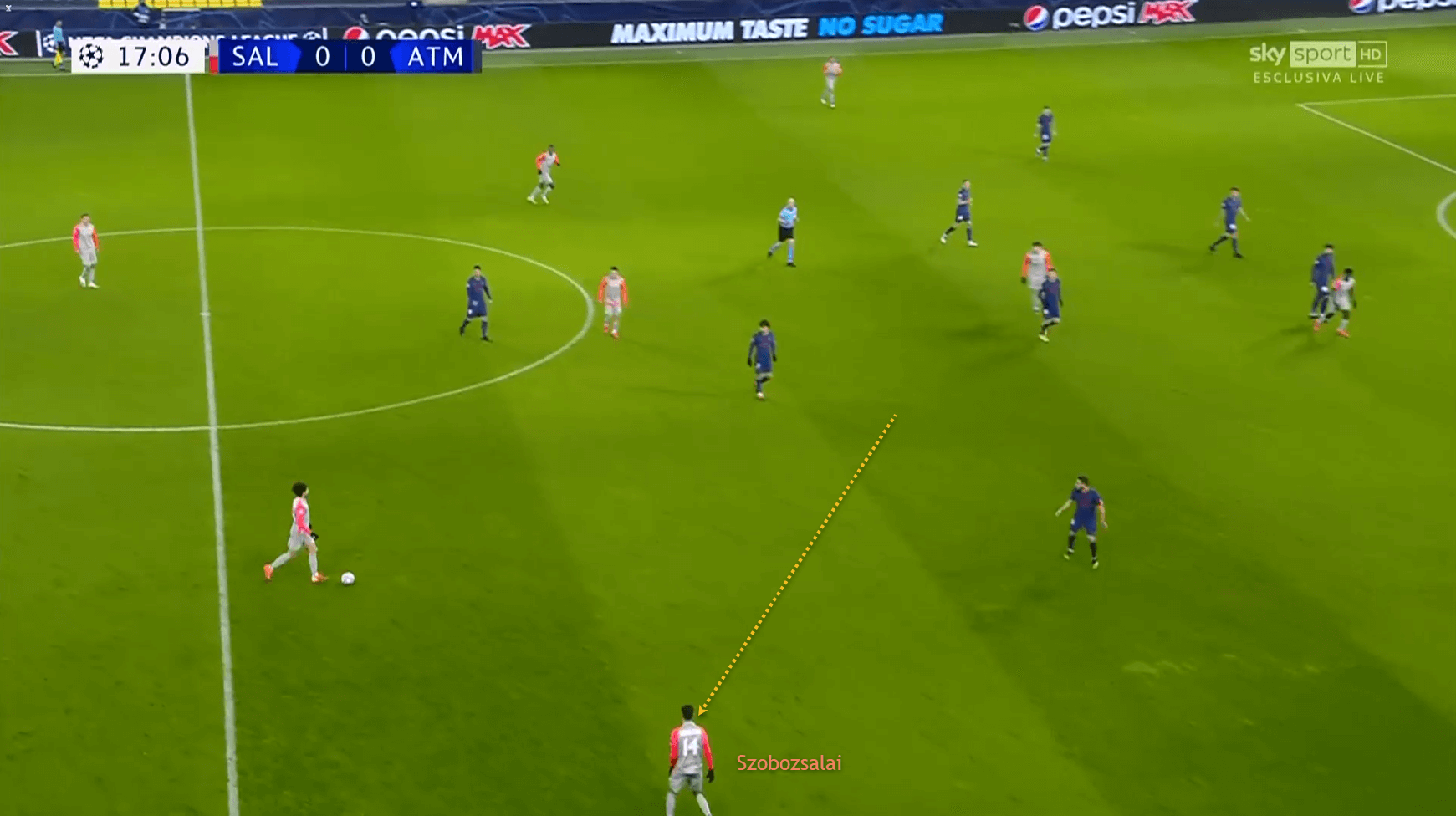
Note how Dominik Szobozsalai has dropped into a right-back position here to give his centre-back a safe passing option if needed – this also allows the right-back to push on and join the attacking line higher up the flank.
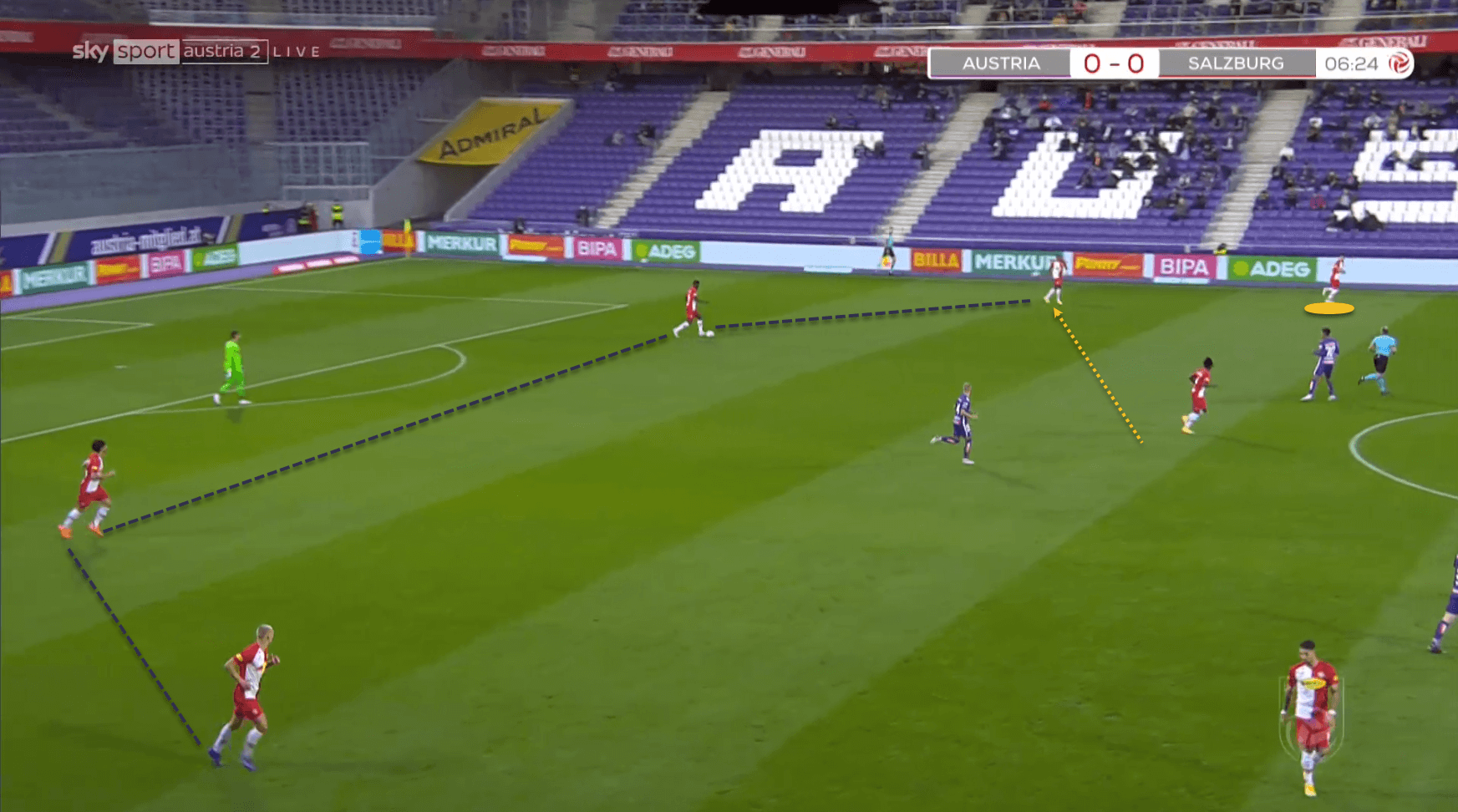
Another example of a midfielder dropping into the backline during the build-up phase – Mady Camara is the one who drops in from midfield into the left-back space here, allowing the actual left-back (yellow circle) to push on.
Salzburg looked to play vertically at all times, and you would often see players on the ball looking for a vertical passing option even from deeper areas. The aim is to go from back to front as quickly as possible to catch opponents out and create goalscoring opportunities.
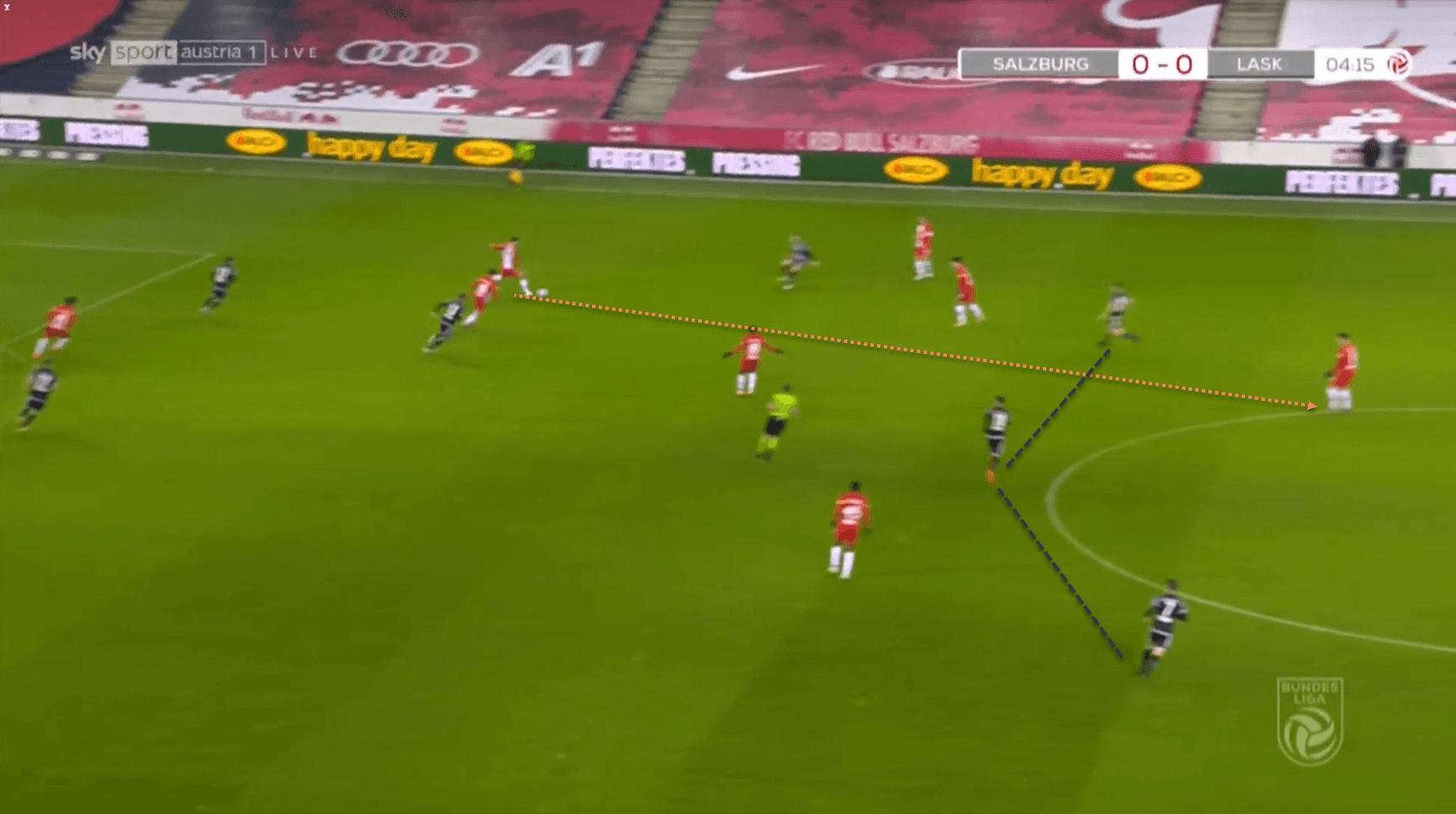
A facet of Salzburg’s play under Marsch which allowed them to do this well was in the positioning of the attacking midfielders. The wide midfielders would tuck infield and play as two number 10s – hence the use of a 4-2-2-2, giving the Salzburg defenders multiple central passing options in between the opposition’s lines. This also helped to create a box shape in midfield along with the two central midfielders, which again gave them numerical superiority, and also allowed for quick combinations to be played due to their proximity to each other.
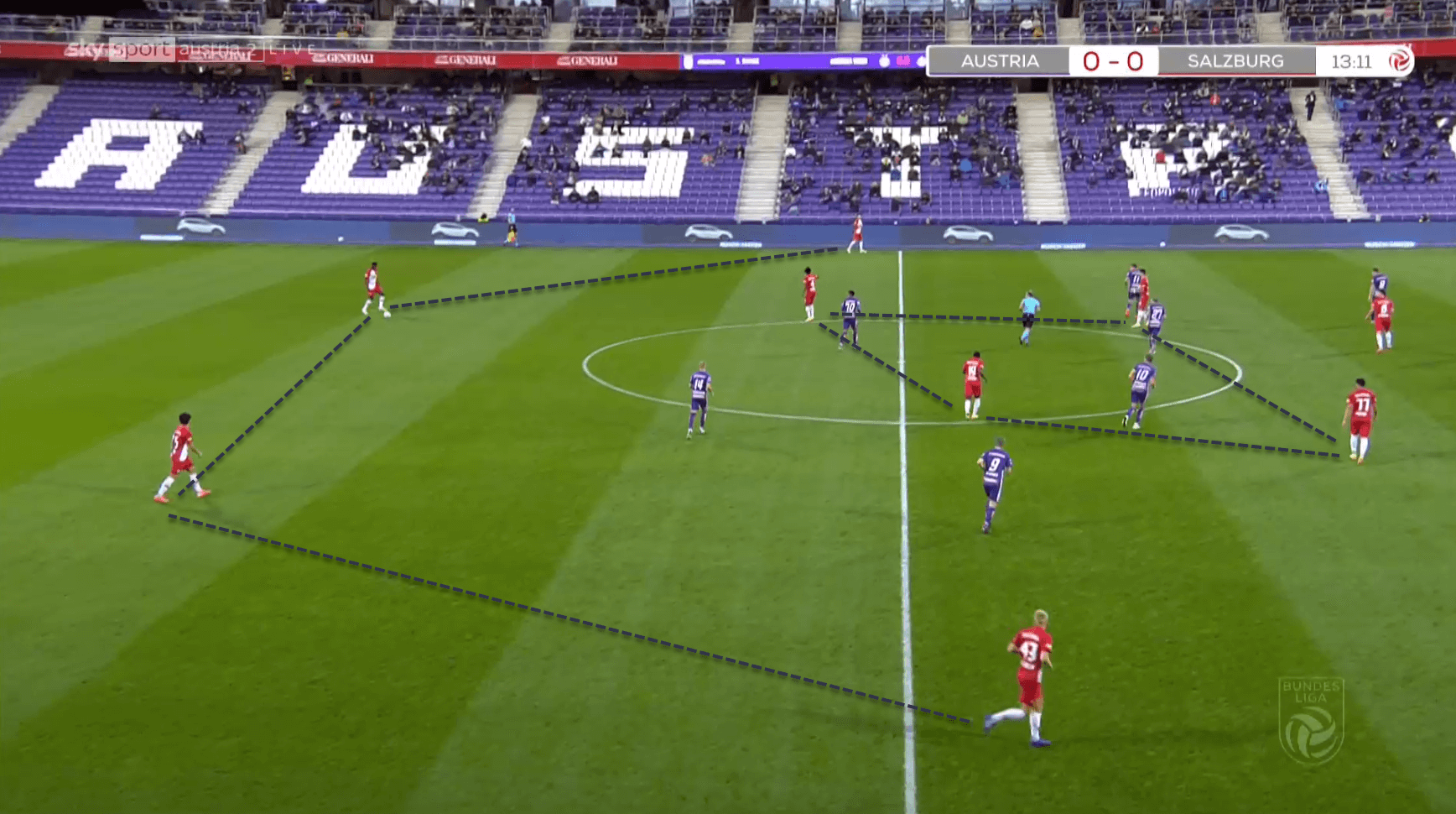
We can see this sort of shape here, with the box also quite evident.
Marsch’s side do not try to force the issue however – if no obvious vertical passes are available, they are content to keep possession and move the ball around quickly to pull opponents out of position and therefore create space to pass forwards.
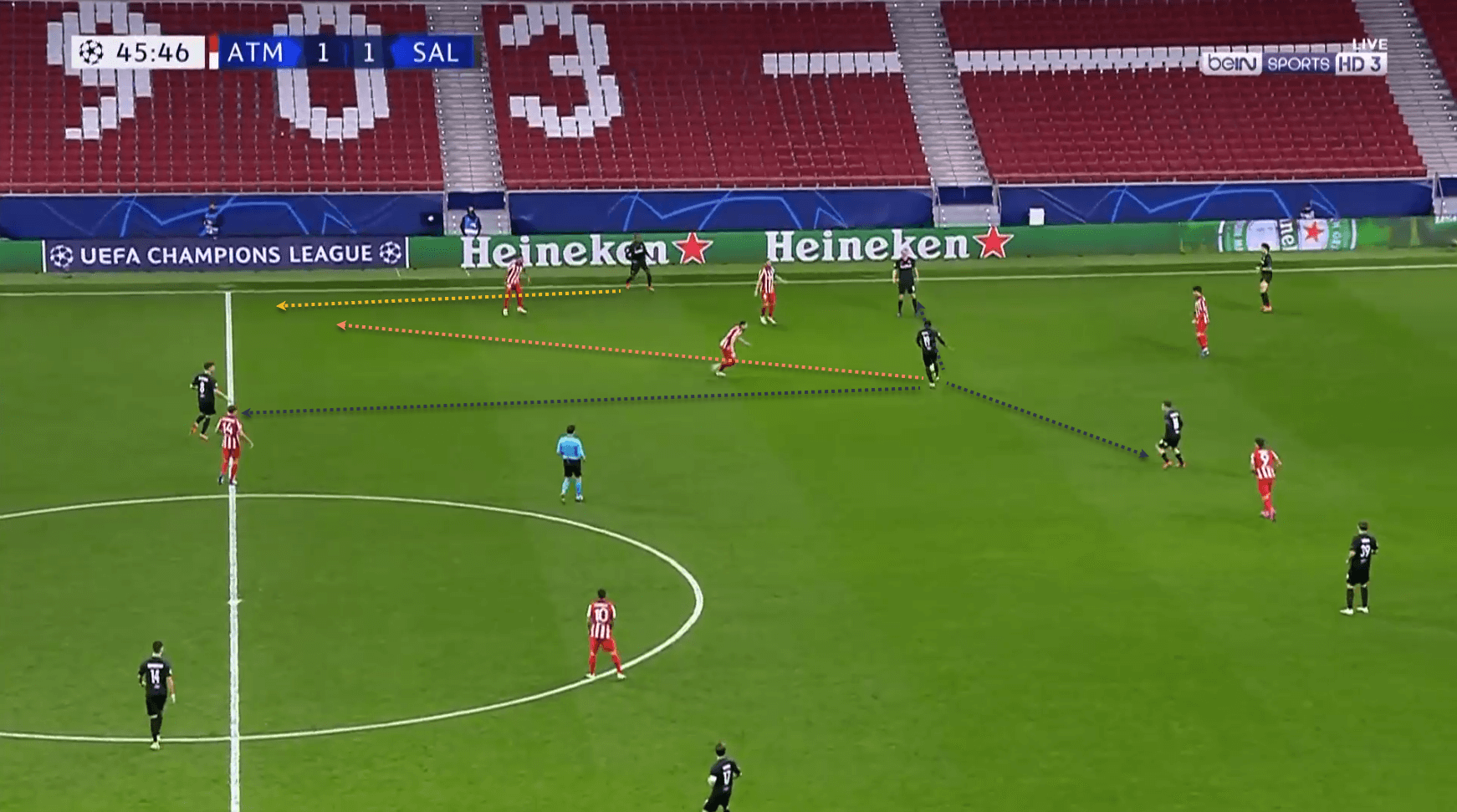
The ball is wide on the right for Salzburg here, and Camara is able to pass to Enock Mwepu on the flank here, but he also has several other passing options available to him.
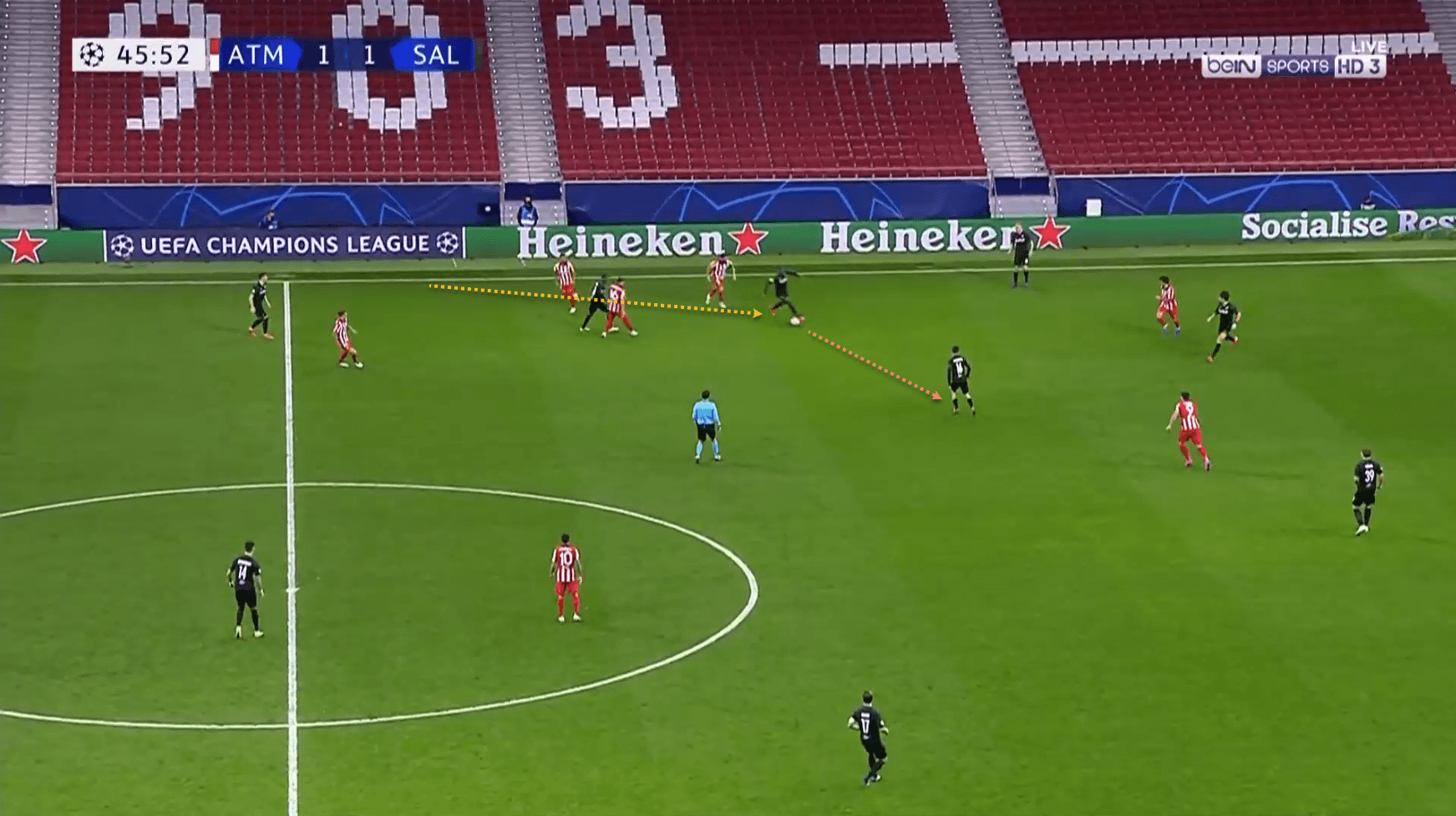
Mwepu dribbles infield and passes to Mergim Berisha, who is in a lot of space.
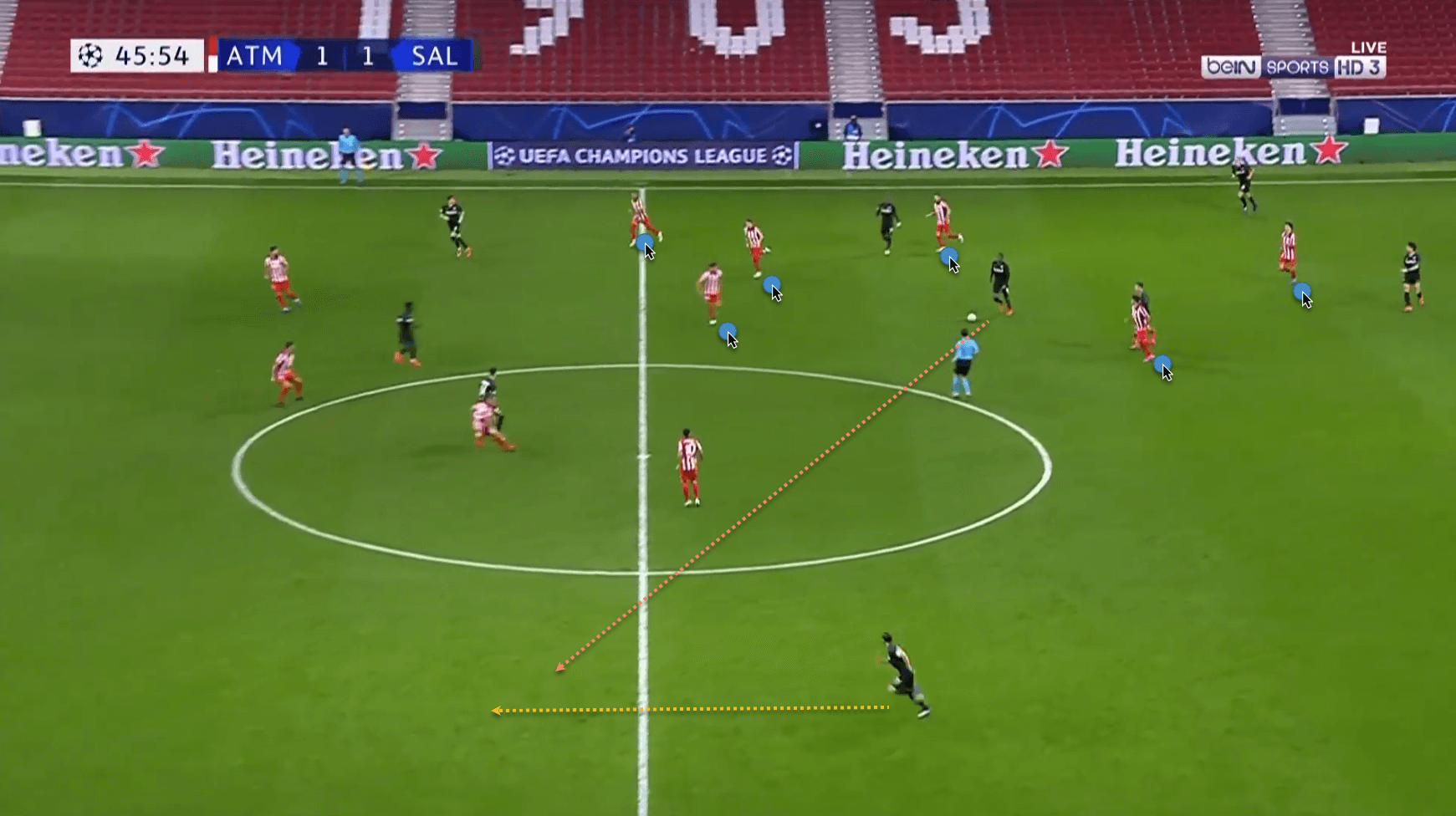
Salzburg were able to draw six Atletico Madrid players over to that side of the pitch, which opens up the switch from Mwepu, who has received the ball back from Berisha, to the left-back Andreas Ulmer, who now has acres of space to bomb forward into.
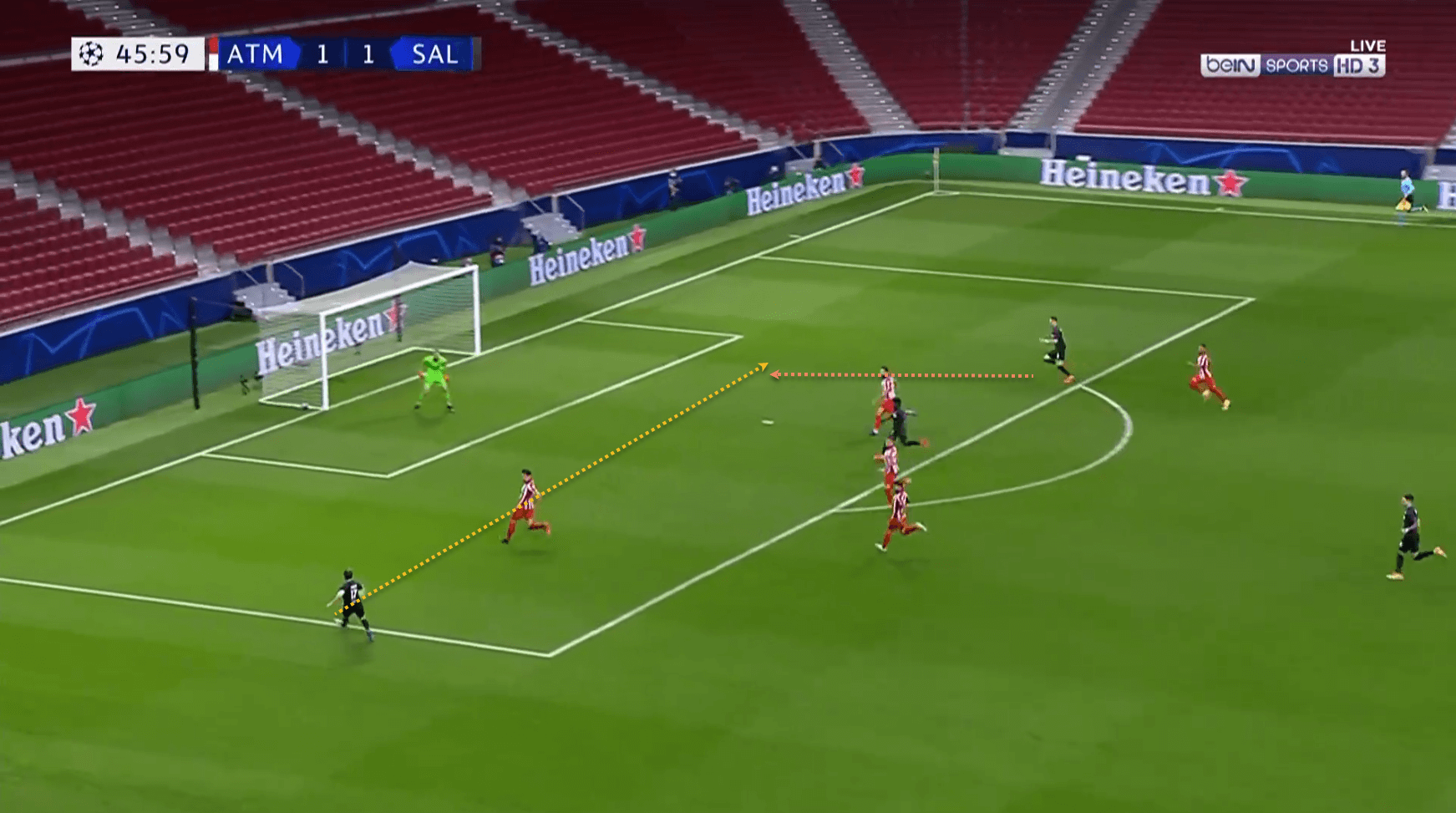
Ulmer reaches the penalty area and sends a low cross towards Szoboszalai, who finishes it off.
This is a perfect example of Salzburg’s approach under Marsch – verticality, ball retention and switches of play. Another facet of his tenure can also be seen here – Salzburg usually crossed low and hard from wide positions for runners into the box to be able to get onto and hit first-time towards goal.
We have already seen how there are some positional rotations during the build-up for Salzburg, and this continues as they progress up the field as well, most notably with the two centre-forwards. One of the two forwards will drop off the backline, looking to receive possession between the lines, while the other will attempt to run in behind and stretch play, and also offer a potential forward passing option. This was the case even on occasions where Salzburg lined up with a lone striker – it would be the number 10 who would drop off in those instances.
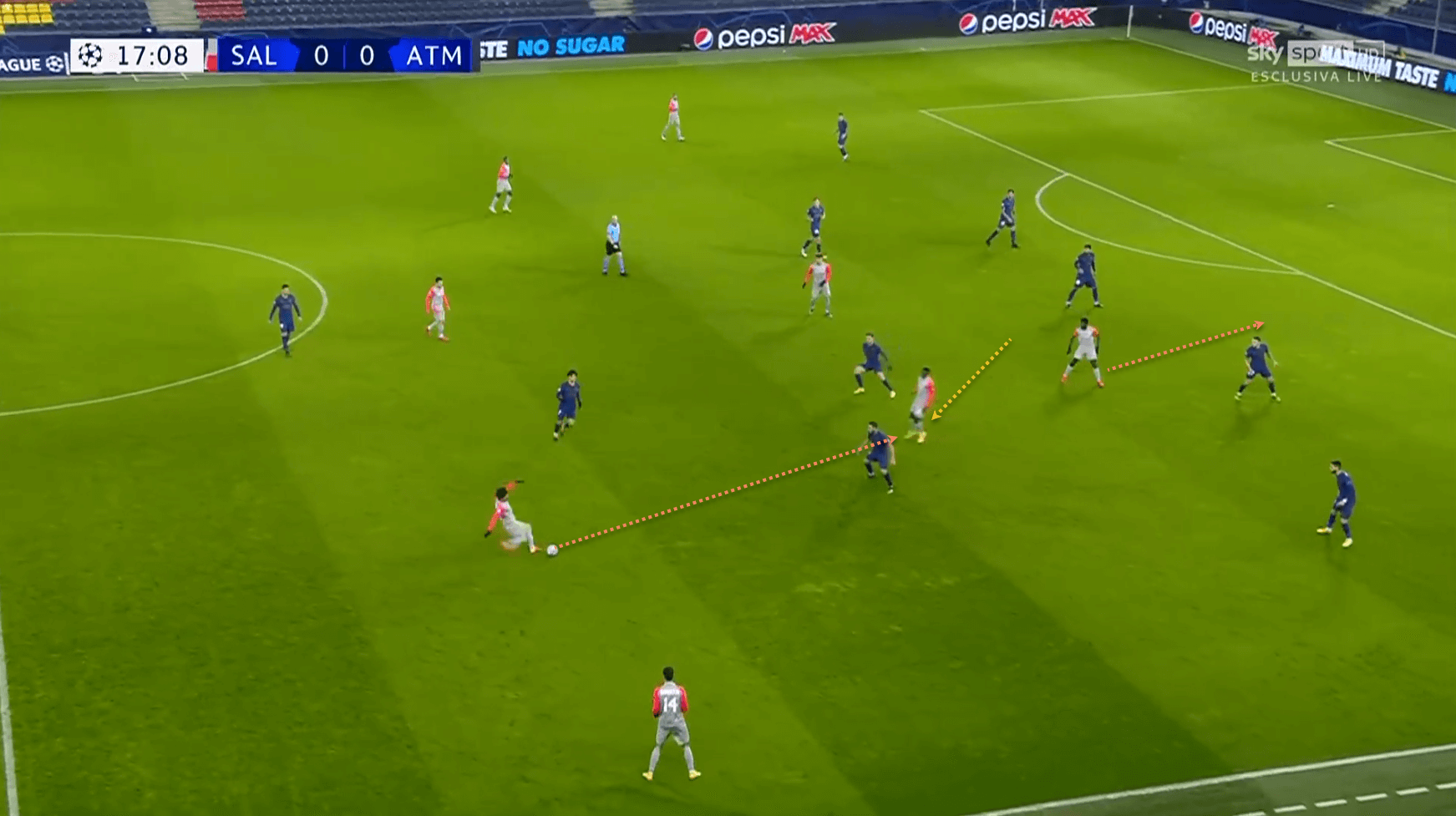
We can see this in action here – Patson Daka drops off, with Seikou Koita staying higher.
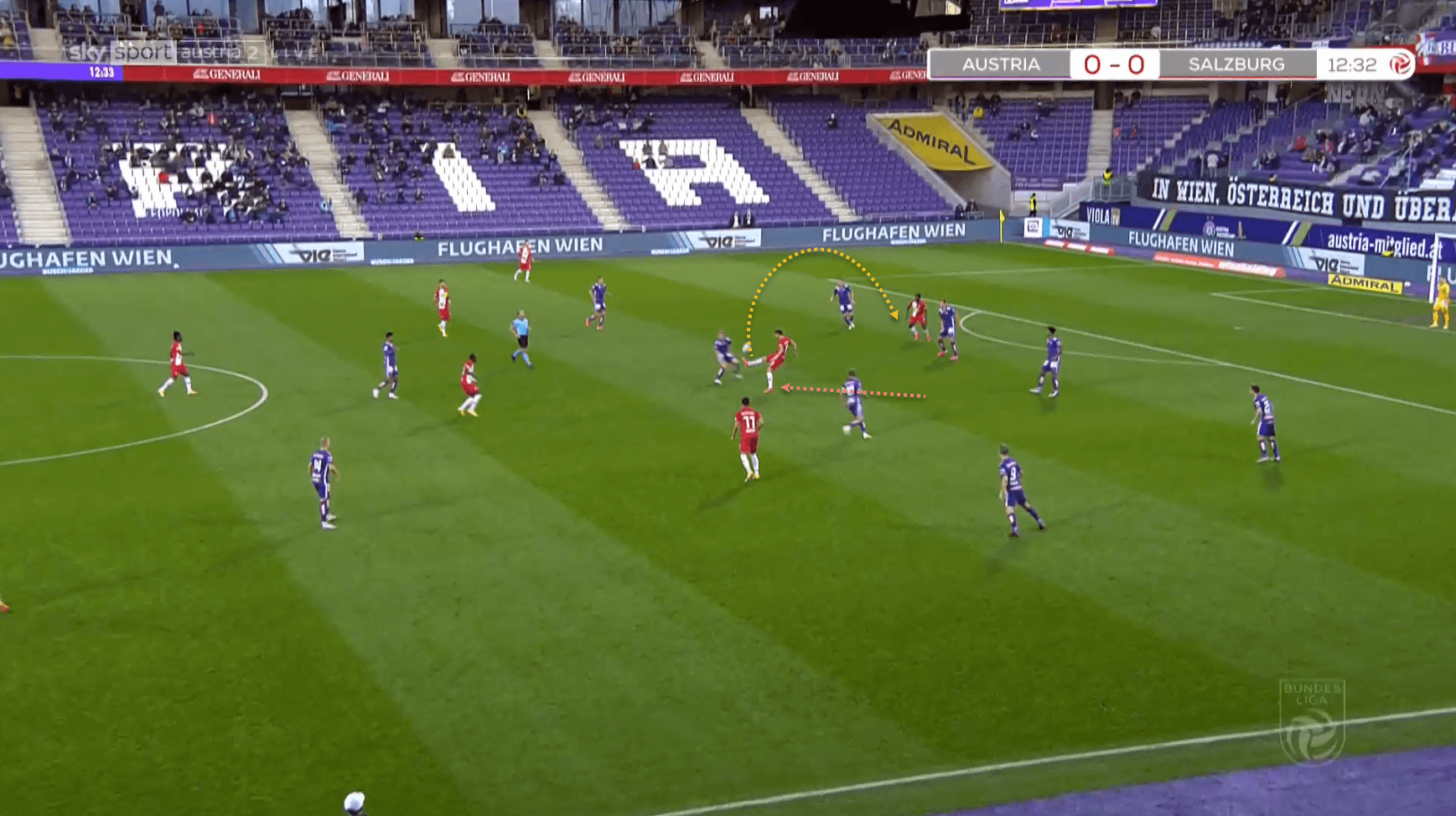
Another example here, this time, it is Berisha dropping off and playing a flick towards Koita.
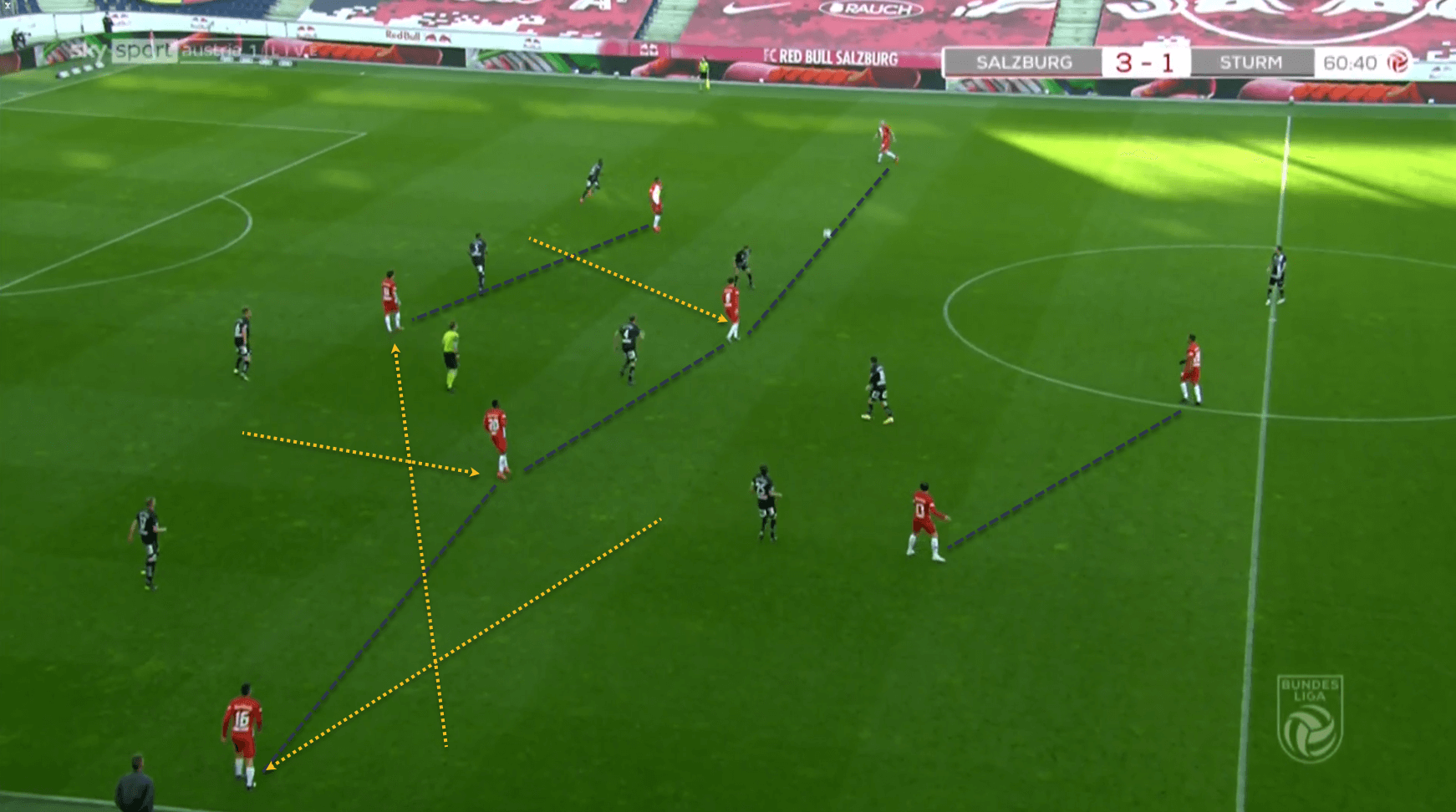
This is a brilliant example of Salzburg’s shape as well as the various rotations. There is a player wide on each flank to stretch play, while the two central players are attempting to get into space between the lines, with two attackers ahead of them, of which one is slightly deeper to drag a defender out and create space in behind. Now, it gets really interesting when we see the players’ positioning. Both strikers, Daka and Berisha, have dropped off to play as the attacking midfielders, while Zlatko Junuzovic is the player on the left flank – he is nominally a central midfielder. Ulmer, the left-back, has moved infield instead. Brenden Aaronson, the left winger, is playing up front instead.
This example shows how there are clear roles in the Salzburg setup, with players expected to fulfil those roles based on their positions on the pitch. We can expect a similar level of fluidity and flexibility from RB Leipzig under Marsch, and as mentioned earlier, there are a number of players in the Leipzig squad who are comfortable playing in multiple positions, which will only make this process easier.
Finally, let us look at another aspect of Salzburg’s play under Marsch that allowed them to play in a quick and vertical fashion, and this is again something that we expect to see replicated quite easily by Leipzig.
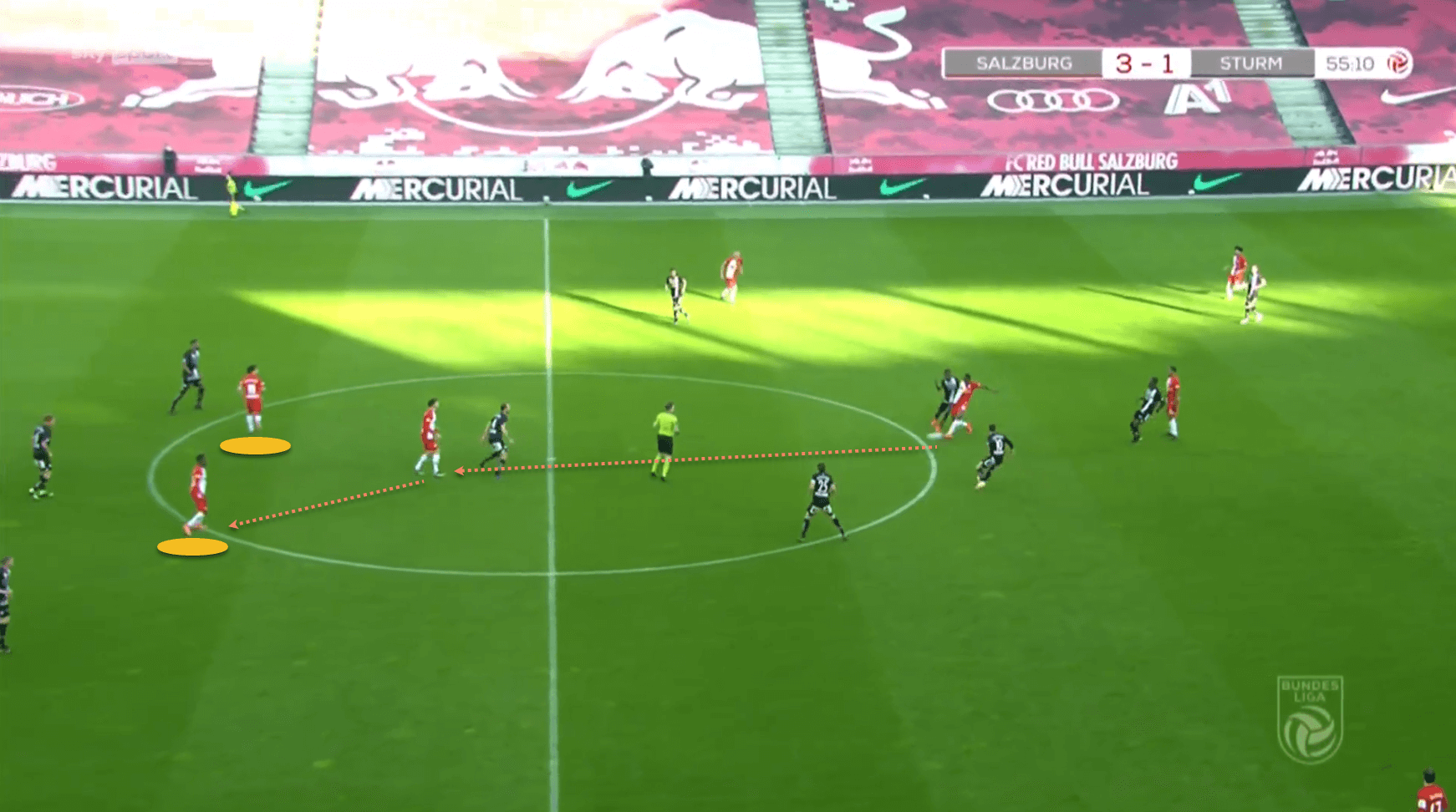
Playing vertical football consistently means that you usually need to have players close to each other when the first vertical pass is made, to allow for quick combination play. Otherwise, the player receiving the ball will be isolated and possession will be lost quite easily. This example shows these principles in action, as when Mwepu passes the ball forward here, Berisha has Daka and Aaronson in close support.
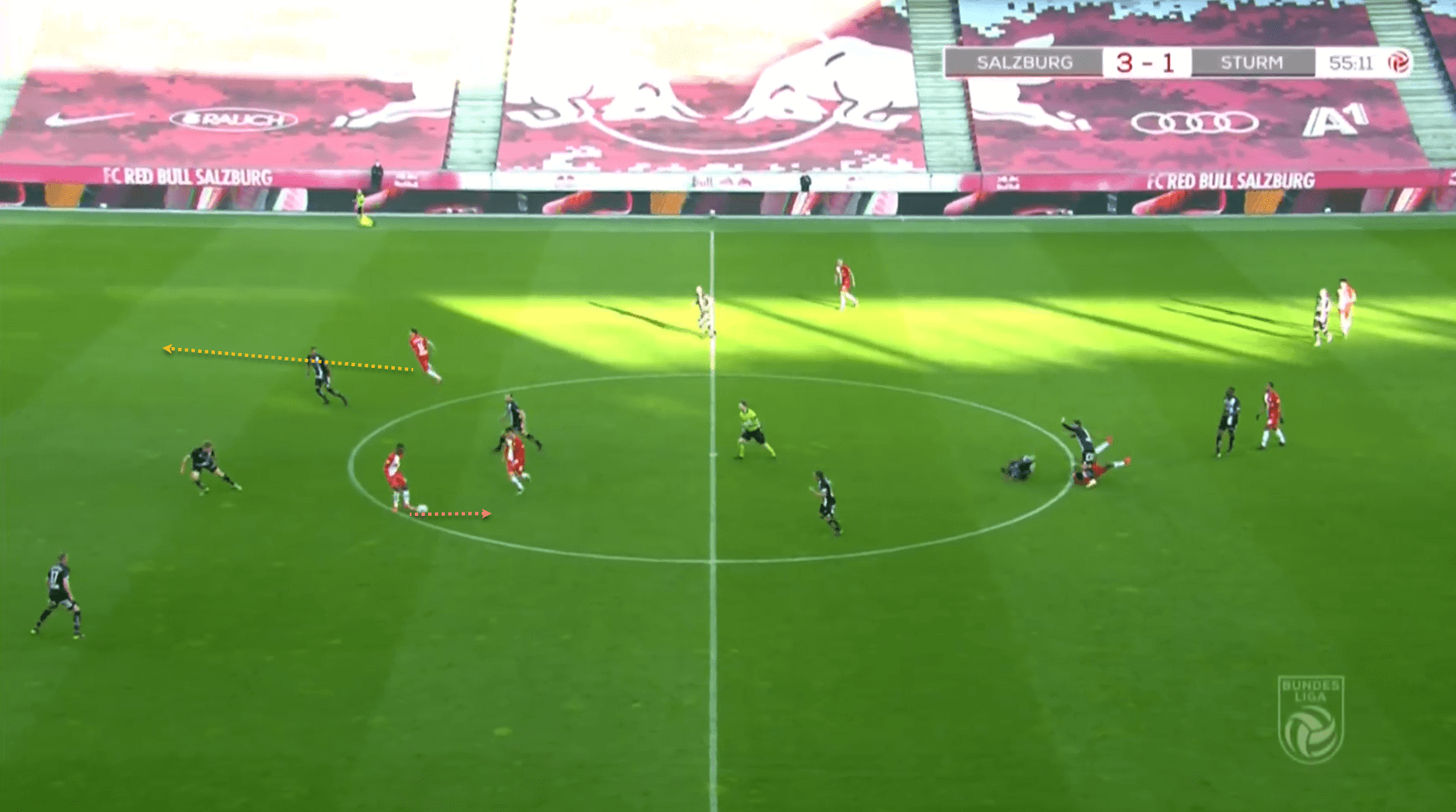
This allows for a quick exchange of passes between the two players, with Aaronson peeling away to run in behind.
Berisha is then able to advance into the Sturm Graz half, with Junuzovic also advancing to offer a potential passing option out wide and making it a 4v4 for Salzburg.
Marsch’s philosophy on the ball can be summed up in this manner – verticality, rotations to create space, and penetrations.
Out of possession
As excellent as RB Salzburg have been in possession, it is perhaps their out of possession approach that has been the most notable. This is generally true of the entire Red Bull network of clubs, as they prioritise regaining the ball immediately after losing it, with a high press and constant counter-pressing. Again, this is something that is therefore common between Salzburg and Leipzig, and will make Marsch’s adaptation quite smooth.
Ball orientation is the key tenet of this approach. Marsch’s sides tend to overload the ball-side with players to try and win it back, while we also saw this being used in possession to recycle possession before a vertical pass is made.
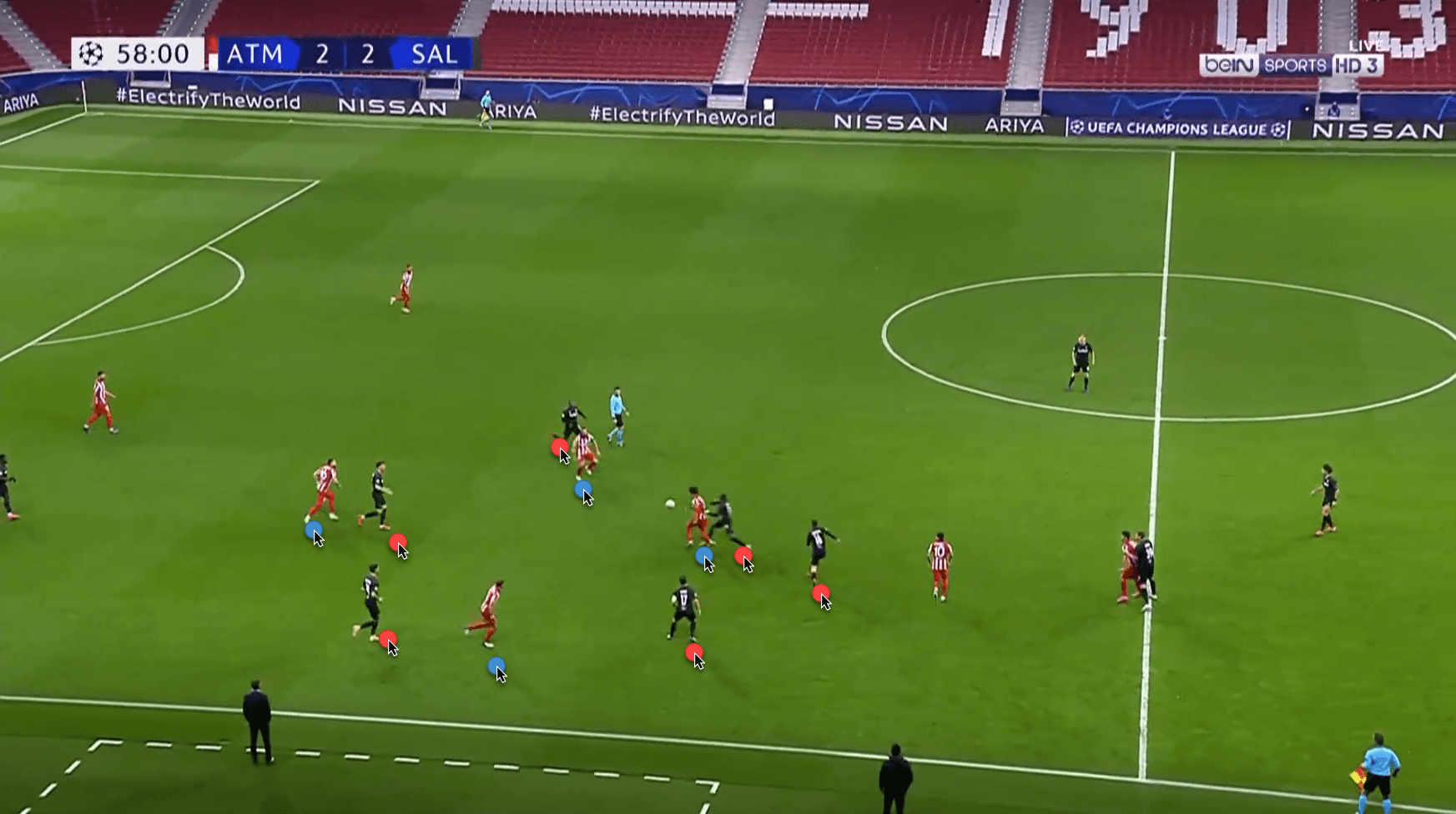
There are six Salzburg players here in the vicinity of the ball against just four Atletico Madrid players, and this makes it easy for the Austrian side to win the ball back here.
When Salzburg lose the ball, they tend to counter-press immediately and energetically. While multiple players will press the man in possession, others will stick tight to potential passing options with the aim of either getting ahead of them to intercept a pass, or preventing them from turning to play a pass forwards and forcing them wide or backwards.
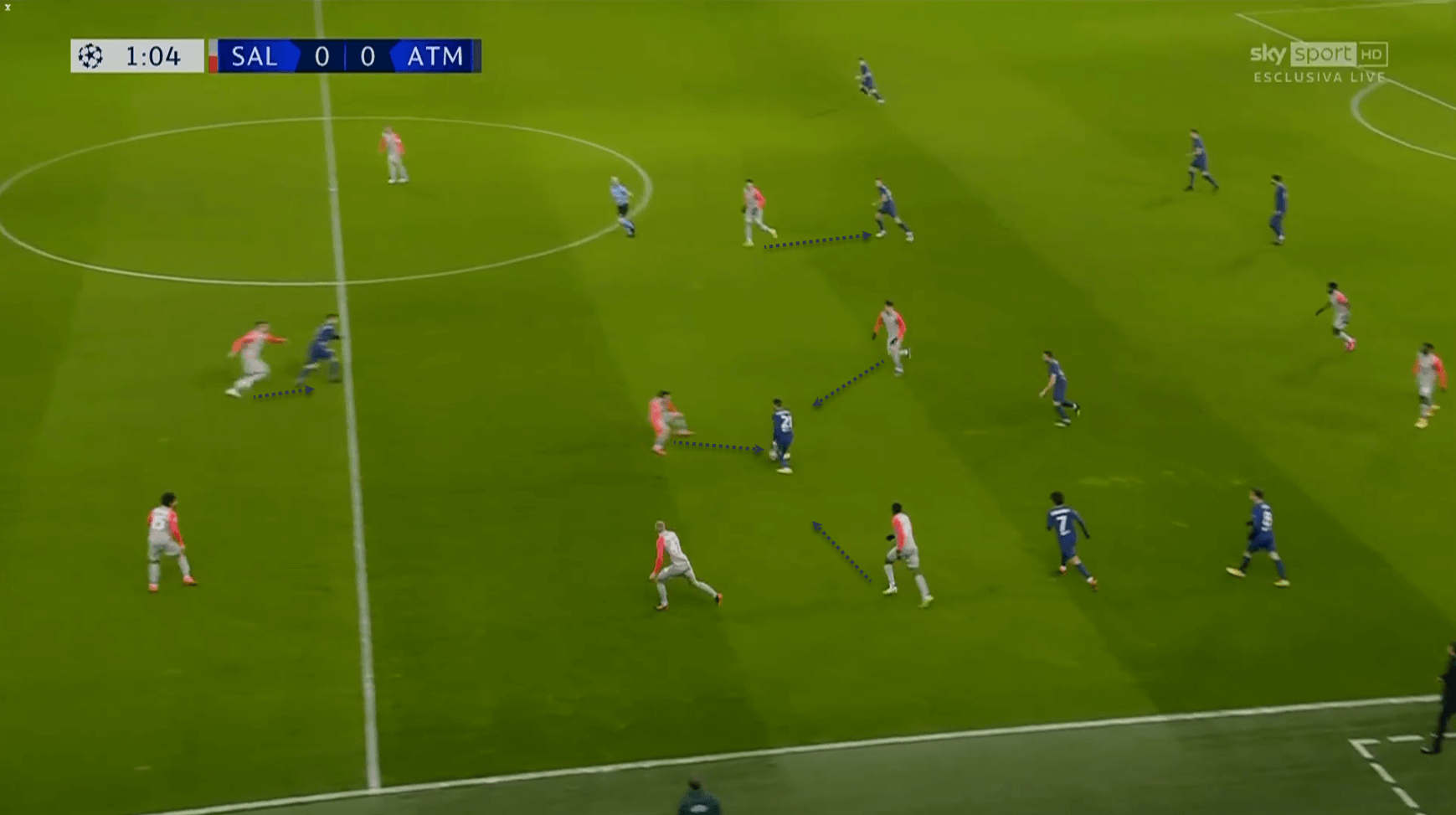
Note how there are at least two Salzburg players immediately pressing the Atletico man in possession, while the centre-back steps up and stays tight to Luis Suarez to ensure that he cannot receive possession easily.
Salzburg’s tendency to press the ball possessor with multiple players also allows them to win the ball back even if the first player is bypassed.
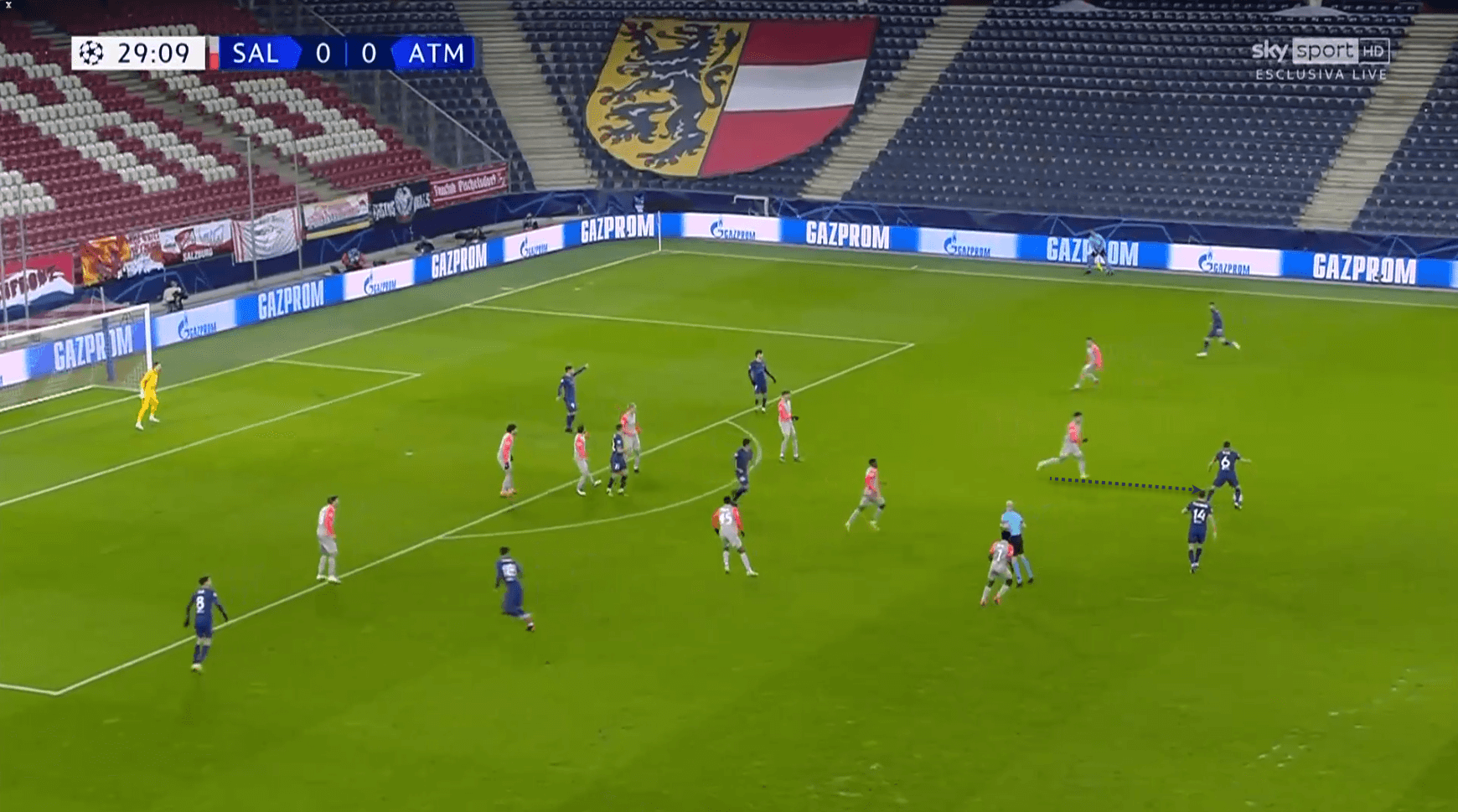
Szoboszalai is first out to Koke here, who bypasses him with a turn inside…
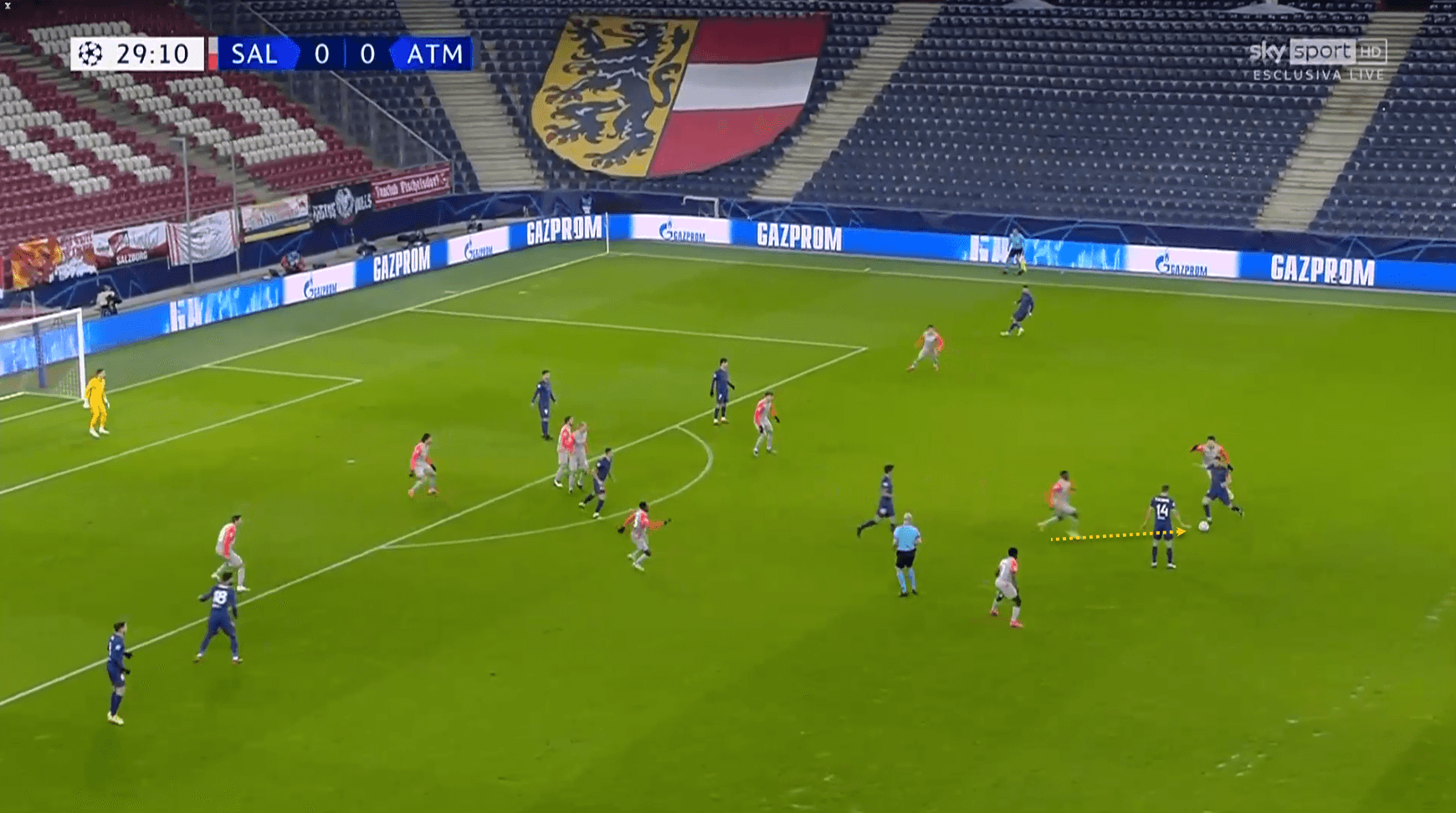
…but finds Daka charging behind him, and ends up losing out, giving Salzburg the opportunity to attack into space.
We have mentioned how Salzburg press high – they do so in a very intelligent manner, cutting off passing options to win the ball back, with this press being ball-oriented. This means that the positioning and movement of the Salzburg players is based on the ball, not the position of the opponents. It is also notable to hear Marsch talk about pressing as an attacking weapon – he has spoken of how he wants his teams to score a goal within 10 seconds of winning the ball back, and ball-orientation plays a role here as well, since Salzburg try to have multiple players around the ball, so that when it is won back, there are enough options to pass out and progress quickly towards goal.
Here is a pretty typical example of how a Marsch side would look at an opposition goal-kick.
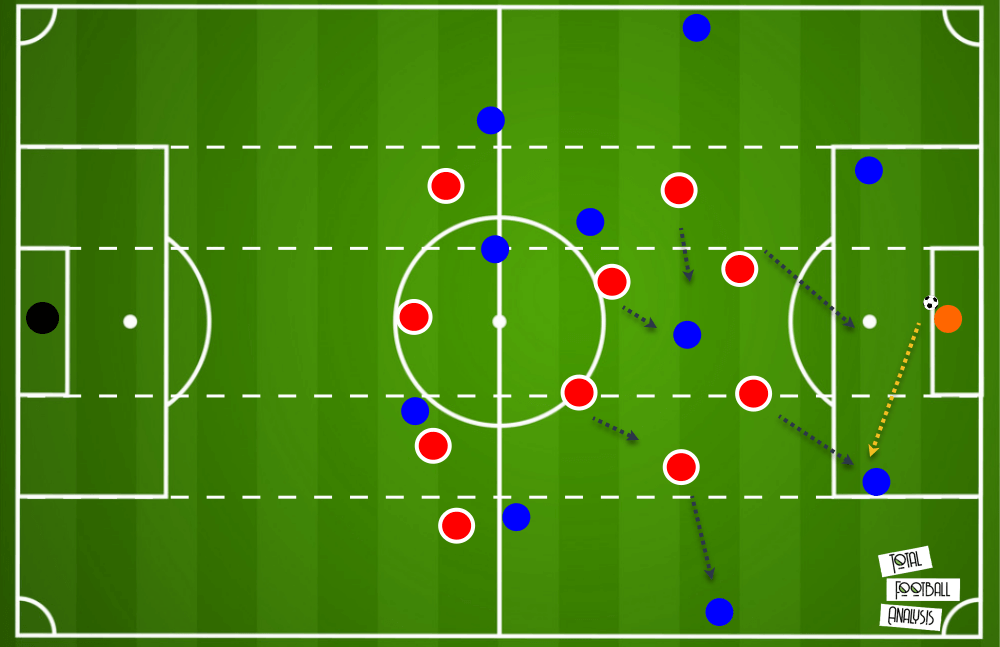
Salzburg stay narrow, with the two ‘tens’ staying in the half-spaces to create numerical overloads in central areas and make it difficult for the opposition to play through them centrally. When the ball is played out to the left-sided centre-back, Salzburg’s press is activated – the right-sided striker leads the press, being near the ball, with the two central midfielders also moving across to maintain compactness, along with the ‘ten’ on the far side. The ‘ten’ on the near side stays ready to sprint across and press the left-back, with Salzburg baiting the opposition into playing the ball to him. They pay no attention to the players on the opposition’s right side, and this is what we mean by ball-oriented.
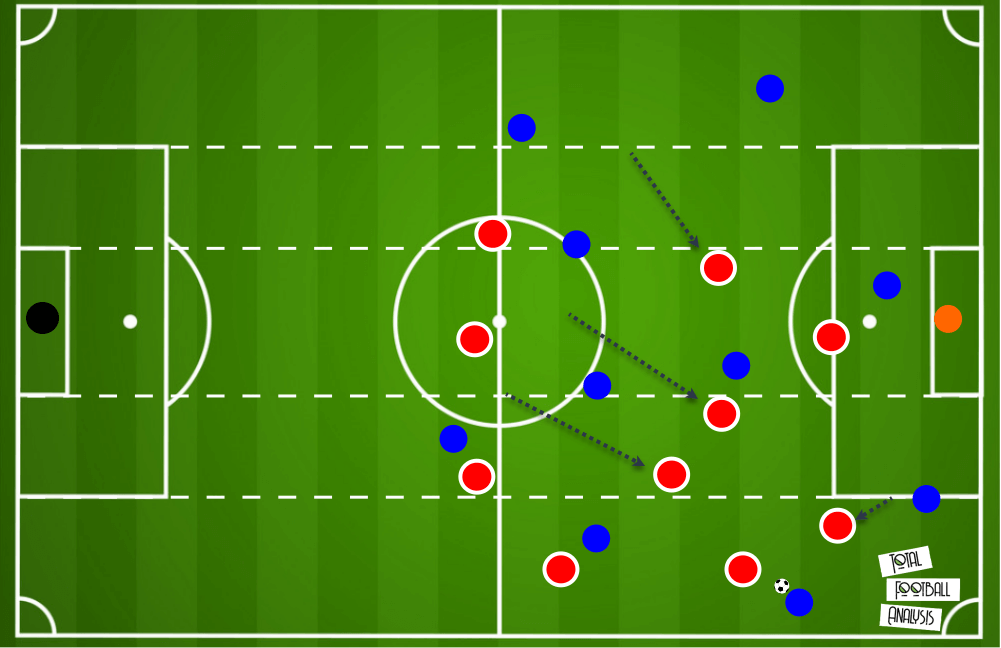
When the ball does get played to the left-back, the press intensifies. The striker presses the left-back from behind while also cutting off the return pass to the left-sided centre-back, with the ‘ten’ having come across as well to create a 2v1 in this area. The left winger is being tracked closely by the Salzburg right-back to rule him out as a passing option as well, while the two central midfielders have also pushed up to cut off central passing options. The right-sided striker is blocking a switch to the goalkeeper or the other centre-back as well, and thus Salzburg will almost certainly end up winning the ball high up the pitch here, with players around the ball to play quickly and advance into the box.
Aggressive pressing and counter-pressing in a ball-oriented manner, with central compactness and overloads, is an accurate summary of Marsch’s approach off the ball.
Suitability to RB Leipzig
RB Leipzig’s squad are used to this approach, with Nagelsmann’s ideas being largely similar to Marsch’s, and so they should have no problems under their new manager. This also means that the profile of players available to him will be well-suited to play in this manner – in fact, Marsch has worked with a number of these players previously at Salzburg as well as at New York Red Bulls, and so they will be even more familiar with his needs and methods. While Leipzig have lost both their starting centre-backs in Dayot Upamecano (Bayern Munich) and Ibrahima Konate (Liverpool), they have already signed excellent replacements in Josko Gvardiol and Mohamed Simakan – both are comfortable on the ball and can play at full-back when needed as well, again emphasizing the flexibility that we spoke about earlier. In midfield, the likes of Tyler Adams, Marcel Sabitzer, Amadou Haidara and Konrad Laimer have all worked with Marsch, and have spent more than enough time at Red Bull clubs to fit into his system with no issues. Dominik Szobozsalai has only just moved to Leipzig from Salzburg in January of this year – Marsh was integral to the Hungarian’s progress, and will look to take him to the next level now. The likes of Dani Olmo and Christopher Nkunku offer excellent options in attacking midfield as well, and again are able to play in multiple positions and roles. Emil Forsberg will also play a big part, again having worked with Marsch in the 2018/19 season. Up front, Alexander Sorloth could be a surprise beneficiary despite having had a difficult start to his Leipzig career, as Marsch has usually favoured one of his strikers to offer a more direct, physical presence. It is the same for Yussuf Poulsen as well, while another former Salzburg player who has worked with Marsch, Hwang Hee-Chan, will be the quick runner in behind. It will be interesting to see if Leipzig add any attackers to their squad this summer – Patson Daka would have been the perfect fit, but the Zambian is set to join Leicester City rather than following his manager and various teammates on the well-trodden path from Salzburg to Leipzig.
Overall, we believe that Marsch will be fit in perfectly at RB Leipzig – he has enough experience in the Red Bull ecosystem as well as with most of the current RB Leipzig squad, and fans can expect to see more of the direct, vertical attacking play that has characterized both him and his new club in the coming seasons.





Comments